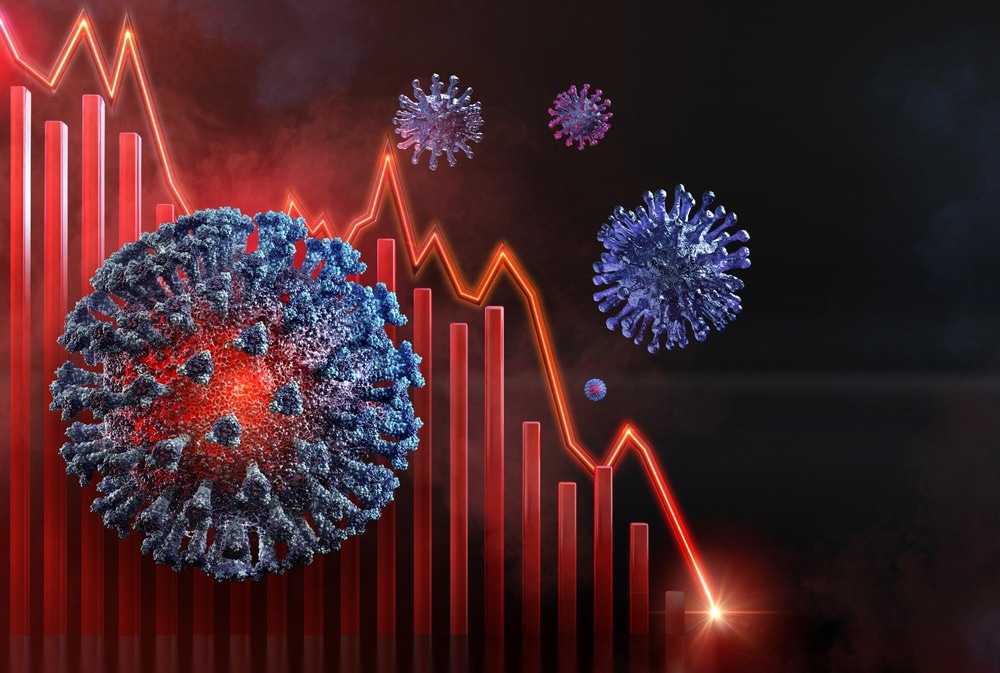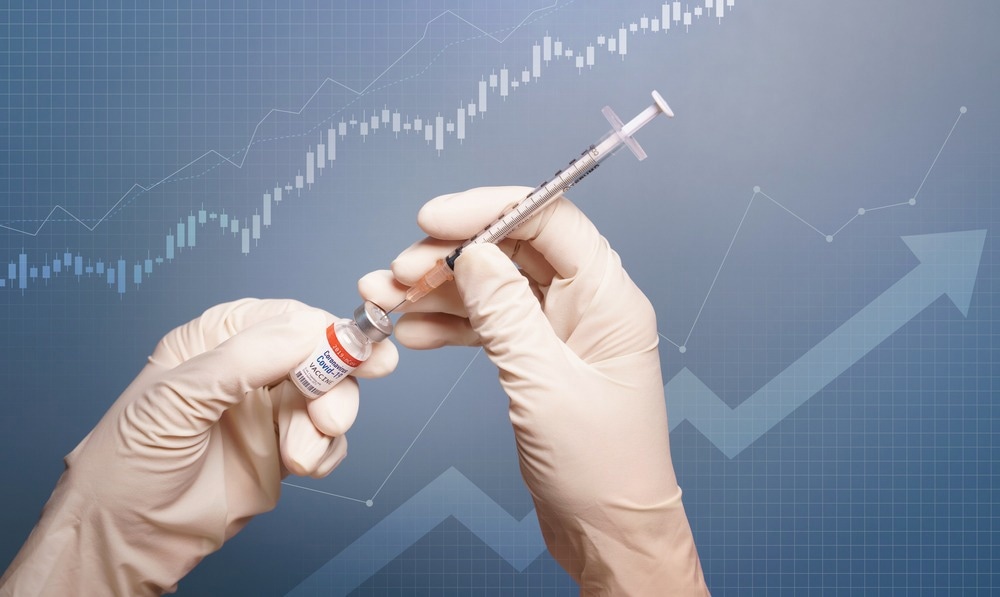The recent SARS-CoV-2 (COVID-19) pandemic has influenced several industries worldwide, especially nanomaterials. Over the global pandemic, it became clear that specific nanomaterials have the potential to be used in the prevention and management of COVID-19.

Image Credit: Corona Borealis Studio/Shutterstock.com
Nanomaterials in the COVID-19 Pandemic
Nanomaterials are materials composed of smaller particles that measure within 1 to 100 nanometers. Due to several unique properties that convey antimicrobial, biocompatible, and low cytotoxic abilities, nanomaterials are useful in treating and managing viral infections.
Nanomaterials were used to address SARS-CoV-2 through applications such as immunoengineering, the production of nanovaccines, surface disinfectants, as base materials for the manufacture of personal protective equipment, and diagnostics for COVID-19.
Also, in combination, through functionalization with other molecules like biosurfactants, the active properties of nanomaterials can become even more effective for future pandemics. The development of these products led to an unprecedented high demand for nanomaterials.
Nanotechnologies Developed to Fight COVID-19
Many nanomaterials are used in COVID-19 therapy, prevention, and diagnostics. These nanoparticles are environmentally friendly, biocompatible, and prevent environmental pollutants from spreading. Some top companies involved in nanomaterials production include American Elements, Strem Chemicals, Inc., US Research Nanomaterials, Inc., Frontier Carbon Corporation, and Nanocomposix, Inc..
Diagnostics
Regarding the detection of the virus, nanotechnology includes methods based on nanoparticles, such as quick antigen testing, as well as methods based on nanopores, such as sequencing and sensing methods.
During the COVID-19 pandemic, there was an increasing demand for point-of-care rapid diagnostics to control COVID-19, encouraged by simultaneous advances in nanobiosensors. For example, point-of-care tests based on selenium nanoparticles that finds anti-SARS-CoV-2 immunoglobulins like IgG and IgM in human serum and blood have been reported. Smart nanobiosensors were also developed for the prevention and management of COVID-19.
Therapeutics
The creation of COVID-19 vaccinations and anti-SARS-CoV-2 nanomaterials both use nanotechnology. For example, the BNT162b2 mRNA vaccine produced by BioNTech and Pfizer uses nanotechnology. More applications involved usage in nanovaccines, drug delivery and repurposing, nanoemulsions, and antimicrobials.
Nanoparticles can transport antiviral medications and, in some situations, can exert their antiviral effects against various viruses, as was already mentioned. They differ significantly from conventional antiviral medicines because they have various targets.
CRISPR and DNA gene treatments could also be delivered using lipid nanoparticles. Exosomes, protein-based nanoparticles, inorganic nanoparticles, and other polymer nanoparticles also deserve consideration as delivery systems for vaccines.

Image Credit: myboys.me/Shutterstock.com
Wearables and Personal Protective Equipment
Nanoparticles can be used as antiviral coatings, airborne virus filters, and facemasks as preventative measures.
The combination of graphene oxide with silver, iron, zinc, and copper nanoparticles increases antiviral activity against enclosed and non-enveloped viruses when used to coat personal protective equipment. Other options include using providing a smart antimicrobial surface. Antimicrobial nanocoatings that respond to temperature can disinfect surfaces for a long time by breaking down the protective coating of the virus when heat is applied.
Nanotechnology in Medicine
Interest in nanomedicine has grown alongside the pandemic as there was an urgent need to find cures and protective materials against COVID-19. Nanomedicine and bionanotechnologies offered a unique and very promising platform to develop the most effective products.
According to recent projections by Precedence Research, the market size for nanomaterials is expected to be worth up to 43.1 billion USD by 2030 at an 18.05% CAGR. They also estimate that the size of the worldwide nanotechnology industry was US$ 85.39 billion in 2021 and is expected to reach US$ 288.71 billion by 2030.
The report also highlights that the largest market share within products is driven by carbon nanotubes, while the largest area of application is the medical field.
Carbon nanotubes have many uses in the medical field, where they are used in diagnosing diseases. Carbon nanotubes offer sensitive detection and accuracy because they have unique optical, mechanical, chemical, and electrical properties with biosensing platforms that detect COVID-19 antibodies in a few seconds.
Impact of COVID-19 on the Nanomaterials Market
Lockdown and economic crisis caused by the COVID-19 pandemic affected the operations of laboratories and companies negatively in the short term. A reduction in labor and disruption of supply chains affected markets.
However, in the long term, there will be market growth due to the many products developed with applications beyond COVID-19. Adopting several personal protective equipment, personal hygiene products, and improved medical diagnostic devices causes long-term needs that will be beneficial in promoting the demand for these products.
Future of Nanomaterials After COVID-19
The application of nanotechnology in the post-pandemic age will help fight SARS-CoV-2 mutations and improve the global delivery of vaccines. In addition to helping control the COVID-19 pandemic, nanotechnology also offers platforms for the early detection, development of vaccinations, and production of antiviral medications and vaccines for potential future viral outbreaks.
Long-term, nanotechnology will act as a technical foundation for the rapid management and prevention of future infections and pandemics. Therefore, the scope of applications only promises to increase even further, and so will be demand for nanomaterials.
References and Further Reading
Carvalho, A.P.A., Conte-Junior, C.A., 2021. Recent Advances on Nanomaterials to COVID-19 Management: A Systematic Review on Antiviral/Virucidal Agents and Mechanisms of SARS-CoV-2 Inhibition/Inactivation. Global Challenges 5, 2000115. https://doi.org/10.1002/gch2.202000115
Çelik, P.A., Manga, E.B., Çabuk, A., Banat, I.M., 2020. Biosurfactants’ potential role in combating COVID-19 and similar future microbial threats. Applied Sciences 11, 334. https://doi.org/10.3390/app11010334
Ghaemi, F., Amiri, A., Bajuri, M.Y., Yuhana, N.Y., Ferrara, M., 2021. Role of different types of nanomaterials against diagnosis, prevention and therapy of COVID-19. Sustainable Cities and Society 72, 103046. https://doi.org/10.1016/j.scs.2021.103046
Gowri, A., Ashwin Kumar, N., Suresh Anand, B.S., 2021. Recent advances in nanomaterials based biosensors for point of care (PoC) diagnosis of Covid-19 – A minireview. TrAC Trends in Analytical Chemistry 137, 116205. https://doi.org/10.1016/j.trac.2021.116205
Guerrini, G., Magrì, D., Gioria, S., Medaglini, D., Calzolai, L., 2022. Characterization of nanoparticles-based vaccines for COVID-19. Nat. Nanotechnol. 17, 570–576. https://doi.org/10.1038/s41565-022-01129-w
Hashemi, B., Akram, F.-A., Amirazad, H., Dadashpour, M., Sheervalilou, M., Nasrabadi, D., Ahmadi, M., Sheervalilou, R., Ameri Shah Reza, M., Ghazi, F., Roshangar, L., 2022. Emerging importance of nanotechnology-based approaches to control the COVID-19 pandemic; focus on nanomedicine iterance in diagnosis and treatment of COVID-19 patients. Journal of Drug Delivery Science and Technology 67, 102967. https://doi.org/10.1016/j.jddst.2021.102967
Khan, M., 2022. Nanotechnology in Point-of-Care Testing [WWW Document]. AZoNano.com. URL https://www.azonano.com/article.aspx?ArticleID=6118
Nanomedicine Market Size and Share | Growth Prediction- 2030 [WWW Document], 2022. Allied Market Research. URL https://www.alliedmarketresearch.com/nanomedicine-market
Research, P., 2022. Nanomaterials Market Size to Worth Around US$ 43.1 Bn by 2030 [WWW Document]. GlobeNewswire News Room. URL https://www.globenewswire.com/en/news-release/2022/06/17/2464947/0/en/Nanomaterials-Market-Size-to-Worth-Around-US-43-1-Bn-by-2030.html
Souri, M., Chiani, M., Farhangi, A., Mehrabi, M.R., Nourouzian, D., Raahemifar, K., Soltani, M., 2022. Anti-COVID-19 Nanomaterials: Directions to Improve Prevention, Diagnosis, and Treatment. Nanomaterials 12, 783. https://doi.org/10.3390/nano12050783
Wang, Z., Zheng, Z., Hu, H., Zhou, Q., Liu, W., Li, X., Liu, Z., Wang, Y. and Ma, Y., 2020. A point-of-care selenium nanoparticle-based test for the combined detection of anti-SARS-CoV-2 IgM and IgG in human serum and blood. Lab on a Chip, 20(22), pp.4255-4261. Available at: https://doi.org/10.1039/D0LC00828A
Xu, C., Lei, C., Hosseinpour, S., Ivanovski, S., Walsh, L.J., Khademhosseini, A., 2022. Nanotechnology for the management of COVID-19 during the pandemic and in the post-pandemic era. National Science Review 9, nwac124. https://doi.org/10.1093/nsr/nwac124
Disclaimer: The views expressed here are those of the author expressed in their private capacity and do not necessarily represent the views of AZoM.com Limited T/A AZoNetwork the owner and operator of this website. This disclaimer forms part of the Terms and conditions of use of this website.